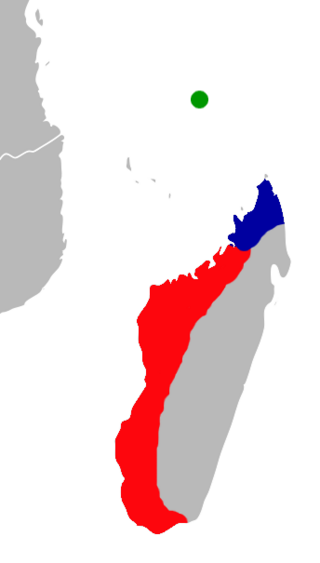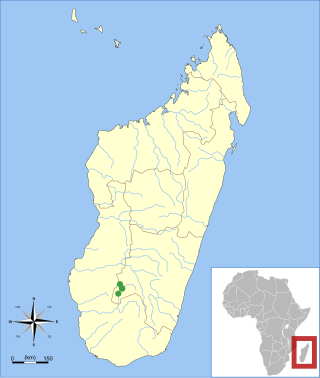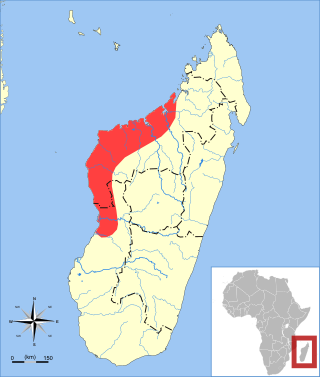Related Research Articles

The lesser yellow bat is a vesper bat found only on Madagascar and Réunion. On Réunion, it was considered common early in the 19th century, but was last sighted late in the 19th century. Only a single specimen attributed to this species, collected in 1868, is known from Madagascar. It was listed as a critically endangered species in 1996 due to habitat loss, and may be extinct.

Peters's wrinkle-lipped bat, also called Peters's goblin bat, is a species of bat in the family Molossidae, the free-tailed bats. It is endemic to Madagascar, where it is widespread and in some areas abundant. It commonly roosts in human-made structures, sometimes in colonies with other free-tailed bat species. It forages in the open, often in agricultural areas. The bat is sexually dimorphic, with males larger than females.

The Malagasy serotine, is a species of vesper bat. It is found only in Madagascar. It was formerly classified in Neoromicia before phylogenetic analysis found it to belong to Laephotis.

The robust yellow bat is a species of vesper bat. It is found only in Madagascar.

Glen's long-fingered bat is a species of vesper bat in the family Miniopteridae found only in Madagascar.

The Manavi long-fingered bat is a bat in the genus Miniopterus that occurs in east-central Madagascar. First described in 1906, this species was later included in the mainland African M. minor. A 1995 revision united populations of small Miniopterus from Madagascar and the Comoros as M. manavi, but molecular and morphological studies in 2008 and 2009 showed that this concept of M. manavi in fact included five different species. M. manavi itself was restricted to a few locations in the eastern Central Highlands and populations in the Comoros and northern and western Madagascar were allocated to different species.

The Madagascan fruit bat is a species of bat in the family Pteropodidae. It is endemic to Madagascar and is listed as "Vulnerable" by the IUCN because it is hunted as bushmeat.

The Malagasy white-bellied free-tailed bat is a species of bat in the family Molossidae. It is endemic to Madagascar.

The Malagasy mouse-eared bat is a species of bat in the family Vespertilionidae that is endemic to Madagascar.

The Madagascar sucker-footed bat, Old World sucker-footed bat, or simply sucker-footed bat is a species of bat in the family Myzopodidae endemic to Madagascar, especially in the eastern part of the forests. The genus was thought to be monospecific until a second species, Myzopoda schliemanni, was discovered in the central western lowlands. It was classified as Vulnerable in the 1996 IUCN Red List of Threatened Species but is now known to be more abundant and was reclassified in 2008 as of "Least Concern".

Grandidier's trident bat is a species of bat in the family Hipposideridae endemic to Madagascar. It was formerly assigned to the genus Triaenops, but is now placed in the separate genus Paratriaenops.

Paratriaenops furcula, also known as Trouessart's trident bat, is a species of bat in the family Hipposideridae. It is endemic to Madagascar. It was formerly assigned to the genus Triaenops, but is now placed in the separate genus Paratriaenops. A related species, Paratriaenops pauliani, occurs in the Seychelles.

Triaenops menamena is a bat in the genus Triaenops found on Madagascar, mainly in the drier regions. It was known as Triaenops rufus until 2009, when it was discovered that that name had been incorrectly applied to the species. Triaenops rufus is a synonym of Triaenops persicus, a Middle Eastern species closely related to T. menamena— the Malagasy species had previously been placed as a subspecies of T. persicus by some authors. Triaenops menamena is mostly found in forests, but also occurs in other habitats. It often roosts in large colonies and eats insects such as butterflies and moths. Because of its wide range, common occurrence, and tolerance of habitat degradation, it is not considered to be threatened.

Pipistrellus raceyi, also known as Racey's pipistrelle, is a bat from Madagascar, in the genus Pipistrellus. Although unidentified species of Pipistrellus had been previously reported from Madagascar since the 1990s, P. raceyi was not formally named until 2006. It is apparently most closely related to the Asian species P. endoi, P. paterculus, and P. abramus, and its ancestors probably reached Madagascar from Asia. P. raceyi has been recorded at four sites, two in the eastern and two in the western lowlands. In the east, it is found in open areas and has been found roosting in a building; in the west it occurs in dry forest. Because of uncertainties about its ecology, it is listed as "Data Deficient" on the IUCN Red List.

The Isalo serotine is a vesper bat of Madagascar in the genus Laephotis. It is known only from the vicinity of the Isalo National Park in the southwestern part of the island, where it has been caught in riverine habitats. After the first specimen was caught in 1967, it was described as a subspecies of Eptesicus somalicus in 1995. After four more specimens were collected in 2002 and 2003, it was recognized as a separate species. Because of its small distribution and the threat of habitat destruction, it is considered "vulnerable" in the IUCN Red List.

The Madagascar free-tailed bat or Malagasy giant mastiff bat is a species of free-tailed bat formerly included as a subspecies of the large-eared free-tailed bat, but that was later considered to be a distinct, Malagasy species. The Madagascar free-tailed bat is endemic to northern, western, and southern Madagascar.

Commerson's roundleaf bat, also known as Commerson's leaf-nosed bat, is a species of bat endemic to Madagascar. It is named after French naturalist Philibert Commerson (1727-1773). Bat populations of Africa or São Tomé and Príncipe formerly considered part of this species are now classified separately as M. gigas, M. thomensis or M. vattatus, while one from Madagascar was split off to become M. cryptovalorona. It was formerly placed in the genus Hipposideros, but moved to the resurrected Macronycteris in 2017 on the basis of molecular evidence.

Mops jobimena, commonly known as the black and red free-tailed bat, is a species of bat in the family Molossidae. It is endemic to western Madagascar. With a forearm length of 45 to 48 mm,

The Marovaza yellow bat or Marovaza house bat is a species of bat found in Madagascar.
Julie Hanta Razafimanahaka is a Malagasy conservation biologist. She has been the director of Madagasikara Voakajy, a conservation nonprofit operating in Eastern Madagascar, since 2011. She began her career as a bat researcher, from 2004 to 2007. In 2015, she was awarded the Young Women in Conservation Award by the International Congress for Conservation Biology.
References
- ↑ Garbutt, 2007, p. 59
- ↑ Bates et al., 2006, p. 321
- 1 2 3 4 5 6 Wilson and Reeder, 2005, p. xxix
- ↑ Nowak, 1994, pp. 48–49; Garbutt, 2007, p. 59
- ↑ Simmons, 2005, p. 321
- ↑ Simmons, 2005, p. 321; Garbutt, 2007, p. 62; Andriafidison et al., 2008a
- ↑ Simmons, 2005, p. 343; Garbutt, 2007, p. 60; Andriafidison et al., 2008b
- ↑ Simmons, 2005, p. 348
- ↑ Simmons, 2005, p. 348; Garbutt, 2007, p. 64; Andriafidison et al., 2008c
- ↑ Nowak, 1994, p. 110; Garbutt, 2007, pp. 68–69; Samonds, 2007; Benda and Vallo, 2009
- ↑ Samonds, 2007, pp. 49ff., 62
- ↑ Foley et al., 2017
- ↑ Simmons, 2005, p. 369; Garbutt, 2007, p. 69; Andriafidison et al., 2008f
- ↑ Goodman et al., 2016
- ↑ Benda and Vallo, 2009, p. 34
- ↑ Simmons, 2005, p. 378; Ranivo and Goodman, 2007, p. 964, appendix 2; Benda and Vallo, 2009, p. 34; Andriafidison et al., 2008o
- ↑ Simmons, 2005, p. 378; Ranivo and Goodman, 2007, p. 964, appendix 2; Benda and Vallo, 2009, p. 34; Andriafidison et al., 2008p
- ↑ Samonds, 2007, pp. 46ff., 62
- ↑ Simmons, 2005, p. 379; Goodman and Ranivo, 2009, p. 54; Benda and Vallo, 2009, p. 34
- ↑ Ranivo and Goodman, 2007, appendix 3; Goodman and Ranivo, 2009, p. 54; Benda and Vallo, 2009, p. 34; Andriafidison et al., 2008q
- ↑ Walker, 1994, pp. 87–88; Garbutt, 2007, p. 64
- ↑ Simmons, 2005, p. 386; Garbutt, 2007, p. 66; Goodman et al., 2008a; Mickleburgh et al., 2008c
- ↑ Goodman et al., 2006a; Garbutt, 2007, p. 65; Jenkins et al., 2008a
- ↑ Goodman et al., 2006a; Garbutt, 2007, p. 66; Jenkins et al., 2008b
- ↑ Simmons, 2005, p. 384; Garbutt, 2007, p. 67; Hutson et al., 2008c
- ↑ Walker, 1994, pp. 101–102; Garbutt, 2007, p. 68
- ↑ Simmons, 2005, pp. 392–393
- ↑ Simmons, 2005, p. 393; Garbutt, 2007, p. 68; Hutson et al., 2008a
- ↑ Gunnell, G. F.; Simmons, N. B.; Seiffert, E. R. (2014-02-04). "New Myzopodidae (Chiroptera) from the Late Paleogene of Egypt: Emended Family Diagnosis and Biogeographic Origins of Noctilionoidea". PLoS ONE . 9 (2): e86712. Bibcode:2014PLoSO...986712G. doi: 10.1371/journal.pone.0086712 . PMC 3913578 . PMID 24504061.
- ↑ Garbutt, 2007, p. 72; Goodman et al., 2007
- ↑ Simmons, 2005, p. 394; Garbutt, 2007, p. 72; Goodman et al., 2007; Jenkins et al., 2008c
- ↑ Garbutt, 2007, p. 73; Goodman et al., 2007; Jenkins et al., 2008d
- ↑ Garbutt, 2007, pp. 80–84
- ↑ Mickleburgh et al., 2008; Goodman et al., 2010c, pp. 1–2
- ↑ Goodman et al., 2010c, pp. 1–2, table 2
- ↑ Goodman and Cardiff, 2004, table 1; Garbutt, 2007, p. 82; Andriafidison et al., 2014
- ↑ Mickleburgh et al., 2008b
- ↑ Goodman and Cardiff, 2004, p. 227; Simmons, 2005, p. 434; Mickleburgh et al., 2008b; Ratrimomanarivo et al., 2009, table 1; Goodman et al., 2010b, p. 128
- ↑ Simmons, 2005, p. 442; Garbutt, 2007, p. 83; Andriafidison et al., 2008n
- ↑ Simmons, 2005, p. 442; Garbutt, 2007, p. 83; Jenkins et al., 2008e
- ↑ Simmons, 2005, p. 445; Garbutt, 2007, p. 80; Andriafidison et al., 2008j
- ↑ Andriafidison et al., 2008k
- ↑ Simmons, 2005, p. 447; Garbutt, 2007, p. 84; Andriafidison et al., 2008k
- ↑ Simmons, 2005, p. 450; Garbutt, 2007, p. 81 Cotterill et al., 2008
- ↑ Simmons, 2005, pp. 519–522
- ↑ Miller-Butterworth et al., 2007, p. 1553
- ↑ Garbutt, 2007, pp. 77–80; subsequent revisions cited below
- ↑ Goodman et al., 2009, p. 6, table 3
- 1 2 Goodman et al., 2009, fig. 1, table 3
- ↑ Goodman et al., 2011, p. 1, table 5
- ↑ Simmons, 2005, p. 519; Andriafidison et al., 2008g; Goodman et al., 2010a, fig. 1, table 1
- ↑ Goodman et al., 2010a, fig. 1, table 1
- ↑ Juste, 2008; Goodman et al., 2009, p. 5, table 3
- ↑ Goodman et al., 2010b, p. 132
- ↑ Simmons, 2005, p. 520; Jenkins and Rakotoarivelo, 2008a; Goodman et al., 2010b, p. 132
- ↑ Goodman et al., 2009, p. 5, table 3; Andriafidison et al., 2008h
- ↑ Goodman et al., 2008b, fig. 1, table 1; 2009, p. 5; Jenkins and Rakotoarivelo, 2008b
- ↑ Goodman et al., 2008b, fig. 1, table 1; Jenkins et al., 2008f
- ↑ Garbutt, 2007, p. 73
- ↑ Garbutt, 2007, pp. 73–77; Bates et al., 2006, p. 299
- ↑ Bates et al., 2006, pp. 299–300
- ↑ Bates et al., 2006, p. 320; Hutson et al., 2008b
- ↑ Simmons, 2005, p. 489; Bates et al., 2006, table 1, fig. 7, p. 319; Jacobs et al., 2008
- ↑ Simmons, 2005, p. 508; Garbutt, 2007, p. 74; Andriafidison et al., 2008i
- ↑ Simmons, 2005, p. 495; Bates et al., 2006, table 1, pp. 313, 315; Andriafidison et al., 2008d
- ↑ Simmons, 2005, p. 456; Bates et al., 2006, table 1, fig. 7, pp. 312–313; Andriafidison et al., 2008e
- ↑ Simmons, 2005, p. 494; Bates et al., 2006, table 1, fig. 7, pp. 315–316; Goodman et al., 2012
- ↑ Simmons, 2005, p. 474; Bates et al., 2006, table 1, fig. 7, pp. 317–318; Mickleburgh et al., 2008a
- ↑ Bates et al., 2006, table 1, fig. 7; Jenkins et al., 2008g
- ↑ Simmons, 2005, p. 465; Goodman et al., 2005, table 1, pp. 871–873; Garbutt, 2007, p. 76; Andriafidison et al., 2008k
- ↑ Goodman et al., 2006b, p. 21, table 1; Jenkins et al., 2008h
- ↑ Simmons, 2005, p. 467; Goodman et al., 2005, table 1, pp. 873–875; Garbutt, 2007, p. 76; Andriafidison et al., 2008l
- ↑ Goodman et al., 2005, table 1, p. 875; Garbutt, 2007, p. 76; Jenkins et al., 2008i